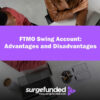Knowing how to manage risk on a funded account is an important training and management strategy that aids success, but this is especially true when managing a funded account. Funded accounts, which are frequently offered by managed accounts or prop firms, have particular regulations that traders must follow to safeguard the firm’s investment as well as their capital. In order to help traders navigate the markets while protecting their capital, this article will examine how to manage risk on a funded account.
Understanding Risk Management
Risk management is the process of detecting, evaluating, and prioritizing risks, followed by concerted attempts to reduce, control, and monitor the likelihood or impact of unfavorable events. Effective risk management is crucial in the context of a funded account for both preserving compliance with the regulations of the funding provider and safeguarding personal capital.
Significance Of Risk Management in Funded Accounts
- Preserving Capital: Capital protection is the main objective of risk management in funded accounts. Your ability to trade successfully may be compromised, and your account may be closed, if you lose a substantial amount of it.
- Respect for Trading Regulations: Strict rules governing maximum withdrawals, position sizes, and loss caps are usually associated with funded accounts. Maintaining funding requires understanding and adherence to these regulations.
- Long-Term Success: By enabling traders to sustain losses and carry on trading without exhausting their cash, effective risk management helps to ensure long-term profitability.
- Psychological Stability: Controlling risk lessens trading-related anxiety. Having a plan in place might help you stay focused and make better decisions when trading.
Important Risk Management Concepts
1. Assess Your Tolerance for Risk
Prior to trading, it is essential to understand your own risk tolerance:
- Determine Your Level of Comfort: Based on your financial status and level of comfort, determine how much risk you are willing to accept on each trade.
- Determine The Risk Parameters: Choose a portion of your overall account balance, usually between 1% and 2%, that you are willing to risk on individual trades.
2. Position Sizing
Position sizing has to do with determining how much money to put into each trade based on your risk tolerance:
Determine the Position Size: Apply the following formula:
- Position Size= Account Risk / Trade Risk
- Account Risk= Total account balance × Percentage risk per trade
- Trae Risk= Entry Price- Stop Loss Price
For instance, your position size would be as follows if you have a $10,000 account and are ready to risk 1% ($100) on a trade with a stop loss set at $5 below the entry price:
Position Size= 100/ 5 = 20 Shares
3. Employ Stop-Loss Orders
Stop-loss orders are crucial instruments for funded account risk management:
- Points of Automatic Exit: To prevent possible losses, a stop-loss order automatically closes your trade when the asset hits a preset price level.
- Terminating Losses: Establish stop-loss levels using volatility metrics (average true range) or technical analysis (support and resistance levels).
4. Put Take-Profit Orders into Action
Take-profit orders are equally as crucial as stop-loss orders:
- Safeguarding Profits: To guarantee that profits are locked in, a take-profit order automatically closes your trade when it hits a predetermined profit threshold.
- Establishing Take-Profit Limits: Apply the same guidelines as stop-loss orders: take desired risk-reward ratios and technical analysis into account.
The Process Of Diversification
To reduce risk, diversification entails distributing investments among several assets or approaches:
- Asset Allocation: If you trade forex, invest in a variety of currency pairings or asset classes, such as equities, bonds, and commodities. This lessens the risk of any one investment doing poorly.
- Learn how various assets move in relation to one another by using correlation analysis. Steer clear of making large investments in highly connected assets since this might increase losses during downturns.
Controlling Leverage
Although leverage raises risk, it enables traders to manage greater positions with smaller sums of capital:
- Recognize Leverage Ratios: Learn the leverage ratios that your funded account provider offers and make careful use of them.
- Limit the Use of Leverage: Keep position sizes reasonable in relation to your account balance and the state of the market to avoid overleveraging.
Keeping An Eye On Performance
Effective funded account risk management requires routine performance monitoring:
- Maintain a Trading Journal: Record every trade, including the entry and departure points, the motivations for the trades, any emotional reactions, and if the take-profit or stop-loss levels were reached. This approach encourages ongoing education and development.
- Examine the Performance Metrics: Examine key performance indicators (KPIs) such win rate, average trading profit/loss, and risk tolerance. Your trading approach may need to be adjusted in light of this analysis.
- Adapt Strategies in Light of Performance: Be willing to change or give up certain tactics in favour of more successful ones if they frequently result in losses or fall short of profit goals.
Aspects of Risk Management That Are Psychological
Handling psychological elements is equally as crucial as handling technical ones:
- Emotional Control: Adhere to your trading strategy without allowing feelings to influence choices. Steer clear of overtrading following wins or retaliatory trading following losses.
- Have Reasonable Expectations: Recognize that trading involves losses; establishing reasonable profit goals can keep you motivated without making you feel let down.
- Take Breaks When Needed: Take breaks to refocus and clear your head if you’re feeling overburdened or anxious about trading decisions.
In conclusion
Knowing how to manage risk on a funded account is essential for long term training success. Traders can protect their capital while navigating the intricacies of the financial markets by knowing their own risk tolerance, using good position sizing strategies, utilizing stop-loss and take-profit orders sparingly, diversifying their investments, managing leverage carefully, keeping a close eye on performance, and addressing psychological factors.
In the end, effective funded account risk management not only protects funded accounts but also lays the groundwork for sustained profitability in the ever-changing realm of foreign exchange trading. Effective risk management tactics will continue to require constant learning and adaptation as markets change and new difficulties emerge.
Frequently Asked Questions
1. What Is Risk Management
- Risk management is the process of detecting, evaluating, and prioritizing risks, followed by concerted attempts to reduce, control, and monitor the likelihood or impact of unfavorable events.
2. What Are The Significance Of Risk Management in Funded Accounts
- Preserving Capital: Capital protection is the main objective of risk management. Your ability to trade successfully may be compromised, and your account may be closed, if you lose a substantial amount of it.
- Respect for Trading Regulations: Strict rules governing maximum withdrawals, position sizes, and loss caps are usually associated with funded accounts. Maintaining funding requires understanding and adherence to these regulations.
- Long-Term Success: By enabling traders to sustain losses and carry on trading without exhausting their cash, effective risk management helps to ensure long-term profitability.
- Psychological Stability: Controlling risk lessens trading-related anxiety. Having a plan in place might help you stay focused and make better decisions when trading.
3. What Are The Aspects of Risk Management That Are Psychological
- Emotional Control: Adhere to your trading strategy without allowing feelings to influence choices. Steer clear of overtrading following wins or retaliatory trading following losses.
- Have Reasonable Expectations: Recognize that trading involves losses; establishing reasonable profit goals can keep you motivated without making you feel let down.
- Take Breaks When Needed: Take breaks to refocus and clear your head if you’re feeling overburdened or anxious about trading decisions.


















